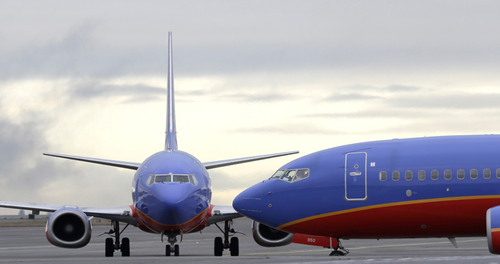Bloomberg has obtained an internal memo from Southwest Airlines that was recently distributed to pilots. The memo details a frightening incident in April when a Boeing 737 Max 8 nearly crashed into the ocean off the coast of Hawaii during an aborted landing.
The memo states Southwest Flight 2786 dropped at an abnormally high rate of more than 4,000 feet per minute before one of the pilots was able to sharply pull back on the yoke, sending the jet climbing at 8,500 feet per minute. The jet was 400 feet from hitting the ocean when the pilot recovered the aircraft.
Data from from flight tracking website ADS-B Exchange shows Flight 2786 dropped from an altitude of about 1,000 feet to 400 feet above the ocean in just a few seconds. The plane was near Lihue Airport on the island of Kauai during the incident.
Flight 2786 mishap was previously unreported and adds to the safety challenges facing the aviation industry, especially Boeing jets.
The memo shows the incident was likely pilot-induced - and not a Max glitch:
According to Southwest's review, the incident occurred following an aborted landing attempt due to inclement weather that blocked the pilots from seeing the runway by a specified altitude.
The captain opted to put the "newer" first officer in command on the short flight to Lihue despite the forecasts, according to the memo.
The less-experienced first officer "inadvertently" pushed forward on the control column, then cut the speed causing the airplane to descend. Soon after, a warning system sounded alarms the jet was getting too close to the surface and the captain ordered the first officer to increase thrust. The plane then "climbed aggressively" at 8,500 feet per minute, the memo said. -BBG
For some context about stable and controlled flight, commercial jets usually glide down on approach at around a rate of 1,500 to 2,000 feet a minute before landing. The 8,500 feet per minute rate is very extreme and not controlled.
Bloomberg noted, "That incident was investigated by both the FAA and NTSB, which found the mishap resulted from a miscommunication between the pilots on the aircraft."
Kit Darby, a former commercial airline pilot and flight instructor, said the pilot was "pitching up and pitching down with the power and close to out of control — very close," adding, "It would feel like a roller coaster ride."
Bloomberg has obtained an internal memo from Southwest Airlines that was recently distributed to pilots. The memo details a frightening incident in April when a Boeing 737 Max 8 nearly crashed into the ocean off the coast of Hawaii during an aborted landing.
The memo states Southwest Flight 2786 dropped at an abnormally high rate of more than 4,000 feet per minute before one of the pilots was able to sharply pull back on the yoke, sending the jet climbing at 8,500 feet per minute. The jet was 400 feet from hitting the ocean when the pilot recovered the aircraft.
Data from from flight tracking website ADS-B Exchange shows Flight 2786 dropped from an altitude of about 1,000 feet to 400 feet above the ocean in just a few seconds. The plane was near Lihue Airport on the island of Kauai during the incident.
Flight 2786 mishap was previously unreported and adds to the safety challenges facing the aviation industry, especially Boeing jets.
The memo shows the incident was likely pilot-induced - and not a Max glitch:
According to Southwest's review, the incident occurred following an aborted landing attempt due to inclement weather that blocked the pilots from seeing the runway by a specified altitude.
The captain opted to put the "newer" first officer in command on the short flight to Lihue despite the forecasts, according to the memo.
The less-experienced first officer "inadvertently" pushed forward on the control column, then cut the speed causing the airplane to descend. Soon after, a warning system sounded alarms the jet was getting too close to the surface and the captain ordered the first officer to increase thrust. The plane then "climbed aggressively" at 8,500 feet per minute, the memo said. -BBG
For some context about stable and controlled flight, commercial jets usually glide down on approach at around a rate of 1,500 to 2,000 feet a minute before landing. The 8,500 feet per minute rate is very extreme and not controlled.
Bloomberg noted, "That incident was investigated by both the FAA and NTSB, which found the mishap resulted from a miscommunication between the pilots on the aircraft."
Kit Darby, a former commercial airline pilot and flight instructor, said the pilot was "pitching up and pitching down with the power and close to out of control — very close," adding, "It would feel like a roller coaster ride."

